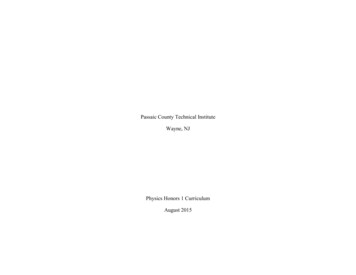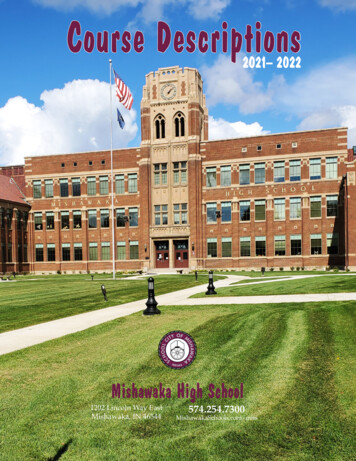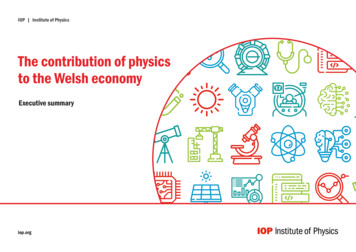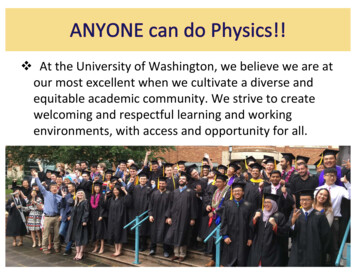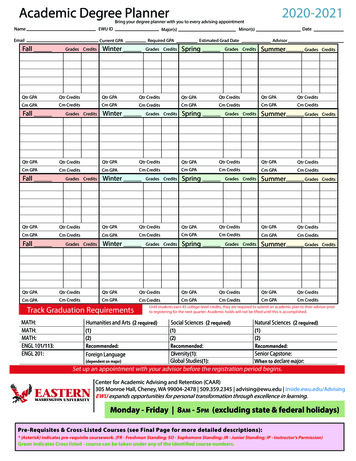
Transcription
PHYSICS (COURSE 8)PHYSICS (COURSE 8)Undergraduate Subjects8.01 Physics IPrereq: NoneU (Fall)3-2-7 units. PHYSICS ICredit cannot also be received for 8.011, 8.012, 8.01L, ES.801,ES.8012Introduces classical mechanics. Space and time: straight-linekinematics; motion in a plane; forces and static equilibrium; particledynamics, with force and conservation of momentum; relativeinertial frames and non-inertial force; work, potential energy andconservation of energy; kinetic theory and the ideal gas; rigid bodiesand rotational dynamics; vibrational motion; conservation of angularmomentum; central force motions; fluid mechanics. Subject taughtusing the TEAL (Technology-Enabled Active Learning) format whichfeatures students working in groups of three, discussing concepts,solving problems, and doing table-top experiments with the aid ofcomputer data acquisition and analysis.J. Formaggio, P. Dourmashkin8.011 Physics IPrereq: NoneU (Spring)5-0-7 units. PHYSICS ICredit cannot also be received for 8.01, 8.012, 8.01L, ES.801,ES.8012Introduces classical mechanics. Space and time: straight-linekinematics; motion in a plane; forces and equilibrium; experimentalbasis of Newton's laws; particle dynamics; universal gravitation;collisions and conservation laws; work and potential energy;vibrational motion; conservative forces; inertial forces and noninertial frames; central force motions; rigid bodies and rotationaldynamics. Designed for students with previous experience in 8.01;the subject is designated as 8.01 on the transcript.D. Pritchard8.012 Physics IPrereq: NoneU (Fall)5-0-7 units. PHYSICS ICredit cannot also be received for 8.01, 8.011, 8.01L, ES.801, ES.8012Elementary mechanics, presented in greater depth than in 8.01.Newton's laws, concepts of momentum, energy, angular momentum,rigid body motion, and non-inertial systems. Uses elementarycalculus freely; concurrent registration in a math subject moreadvanced than 18.01 is recommended. In addition to covering thetheoretical subject matter, students complete a small experimentalproject of their own design. Freshmen admitted via AP or MathDiagnostic for Physics Placement results.M. Soljacic8.01L Physics IPrereq: NoneU (Fall, IAP)3-2-7 units. PHYSICS ICredit cannot also be received for 8.01, 8.011, 8.012, ES.801, ES.8012Introduction to classical mechanics (see description under 8.01).Includes components of the TEAL (Technology-Enabled ActiveLearning) format. Material covered over a longer interval so that thesubject is completed by the end of the IAP. Substantial emphasisgiven to reviewing and strengthening necessary mathematicstools, as well as basic physics concepts and problem-solving skills.Content, depth, and di culty is otherwise identical to that of 8.01.The subject is designated as 8.01 on the transcript.P. Jarillo-Herrero8.02 Physics IIPrereq: Calculus I (GIR) and Physics I (GIR)U (Fall, Spring)3-2-7 units. PHYSICS IICredit cannot also be received for 8.021, 8.022, ES.802, ES.8022Introduction to electromagnetism and electrostatics: electriccharge, Coulomb's law, electric structure of matter; conductorsand dielectrics. Concepts of electrostatic eld and potential,electrostatic energy. Electric currents, magnetic elds and Ampere'slaw. Magnetic materials. Time-varying elds and Faraday's lawof induction. Basic electric circuits. Electromagnetic waves andMaxwell's equations. Subject taught using the TEAL (TechnologyEnabled Active Learning) studio format which utilizes small groupinteraction and current technology to help students develop intuitionabout, and conceptual models of, physical phenomena.J. Belcher, I. CissePhysics (Course 8) 3
PHYSICS (COURSE 8)8.021 Physics IIPrereq: Calculus I (GIR), Physics I (GIR), and permission of instructorU (Fall)5-0-7 units. PHYSICS IICredit cannot also be received for 8.02, 8.022, ES.802, ES.8022Introduction to electromagnetism and electrostatics: electriccharge, Coulomb's law, electric structure of matter; conductorsand dielectrics. Concepts of electrostatic eld and potential,electrostatic energy. Electric currents, magnetic elds and Ampere'slaw. Magnetic materials. Time-varying elds and Faraday'slaw of induction. Basic electric circuits. Electromagnetic wavesand Maxwell's equations. Designed for students with previousexperience in 8.02; the subject is designated as 8.02 on thetranscript. Enrollment limited.J. Checkelsky8.022 Physics IIPrereq: Physics I (GIR); Coreq: Calculus II (GIR)U (Fall, Spring)5-0-7 units. PHYSICS IICredit cannot also be received for 8.02, 8.021, ES.802, ES.8022Parallel to 8.02, but more advanced mathematically. Someknowledge of vector calculus assumed. Maxwell's equations, inboth di erential and integral form. Electrostatic and magneticvector potential. Properties of dielectrics and magnetic materials.In addition to the theoretical subject matter, several experimentsin electricity and magnetism are performed by the students in thelaboratory.D. Harlow8.03 Physics IIIPrereq: Calculus II (GIR) and Physics II (GIR)U (Fall, Spring)5-0-7 units. RESTMechanical vibrations and waves; simple harmonic motion,superposition, forced vibrations and resonance, coupledoscillations, and normal modes; vibrations of continuous systems;reflection and refraction; phase and group velocity. Optics; wavesolutions to Maxwell's equations; polarization; Snell's Law,interference, Huygens's principle, Fraunhofer di raction, andgratings.Y-J. Lee, R. Comin4 Physics (Course 8)8.033 RelativityPrereq: Calculus II (GIR) and Physics II (GIR)U (Fall)5-0-7 units. RESTEinstein's postulates; consequences for simultaneity, timedilation, length contraction, and clock synchronization; Lorentztransformation; relativistic e ects and paradoxes; Minkowskidiagrams; invariants and four-vectors; momentum, energy, andmass; particle collisions. Relativity and electricity; Coulomb'slaw; magnetic elds. Brief introduction to Newtonian cosmology.Introduction to some concepts of general relativity; principle ofequivalence. The Schwarzchild metric; gravitational red shi ;particle and light trajectories; geodesics; Shapiro delay.S. Vitale8.04 Quantum Physics IPrereq: 8.03 and (18.03 or 18.032)U (Spring)5-0-7 units. RESTCredit cannot also be received for 8.041Experimental basis of quantum physics: photoelectric e ect,Compton scattering, photons, Franck-Hertz experiment, the Bohratom, electron di raction, deBroglie waves, and wave-particleduality of matter and light. Introduction to wave mechanics:Schroedinger's equation, wave functions, wave packets, probabilityamplitudes, stationary states, the Heisenberg uncertainty principle,and zero-point energies. Solutions to Schroedinger's equation inone dimension: transmission and reflection at a barrier, barrierpenetration, potential wells, the simple harmonic oscillator.Schroedinger's equation in three dimensions: central potentials andintroduction to hydrogenic systems.V. Vuletic
PHYSICS (COURSE 8)8.041 Quantum Physics I8.05 Quantum Physics IIBlended version of 8.04 using a combination of online and inperson instruction. Covers experimental basis of quantum physics:photoelectric e ect, Compton scattering, photons, Franck-Hertzexperiment, the Bohr atom, electron di raction, deBroglie waves,and wave-particle duality of matter and light. Introduction to wavemechanics: Schroedinger's equation, wave functions, wave packets,probability amplitudes, stationary states, the Heisenberg uncertaintyprinciple, and zero-point energies. Solutions to Schroedinger'sequation in one dimension: transmission and reflection at a barrier,barrier penetration, potential wells, the simple harmonic oscillator.Schroedinger's equation in three dimensions: central potentials andintroduction to hydrogenic systems.V. VuleticTogether 8.05 and 8.06 cover quantum physics with applicationsdrawn from modern physics. General formalism of quantummechanics: states, operators, Dirac notation, representations,measurement theory. Harmonic oscillator: operator algebra, states.Quantum mechanics in three dimensions: central potentials and theradial equation, bound and scattering states, qualitative analysis ofwavefunctions. Angular momentum: operators, commutator algebra,eigenvalues and eigenstates, spherical harmonics. Spin: SternGerlach devices and measurements, nuclear magnetic resonance,spin and statistics. Addition of angular momentum: Clebsch-Gordanseries and coe cients, spin systems, and allotropic forms ofhydrogen.W. Detmold8.044 Statistical Physics I8.051 Quantum Physics IIPrereq: 8.03 and (18.03 or 18.032)U (Fall)2-0-10 units. RESTCredit cannot also be received for 8.04Prereq: 8.03 and 18.03U (Spring)5-0-7 unitsIntroduction to probability, statistical mechanics, andthermodynamics. Random variables, joint and conditionalprobability densities, and functions of a random variable. Conceptsof macroscopic variables and thermodynamic equilibrium,fundamental assumption of statistical mechanics, microcanonicaland canonical ensembles. First, second, and third laws ofthermodynamics. Numerous examples illustrating a wide variety ofphysical phenomena such as magnetism, polyatomic gases, thermalradiation, electrons in solids, and noise in electronic devices.Concurrent enrollment in 8.04 is recommended.N. FakhriPrereq: 8.04U (Fall)5-0-7 unitsCredit cannot also be received for 8.051Prereq: 8.04 and permission of instructorU (Spring)2-0-10 unitsCredit cannot also be received for 8.05Blended version of 8.05 using a combination of online andin-person instruction. Together with 8.06 covers quantumphysics with applications drawn from modern physics. Generalformalism of quantum mechanics: states, operators, Diracnotation, representations, measurement theory. Harmonicoscillator: operator algebra, states. Quantum mechanics in threedimensions: central potentials and the radial equation, bound andscattering states, qualitative analysis of wave functions. Angularmomentum: operators, commutator algebra, eigenvalues andeigenstates, spherical harmonics. Spin: Stern-Gerlach devices andmeasurements, nuclear magnetic resonance, spin and statistics.Addition of angular momentum: Clebsch-Gordan series andcoe cients, spin systems, and allotropic forms of hydrogen. Limitedto 20.Fall: Sta Spring: W. DetmoldPhysics (Course 8) 5
PHYSICS (COURSE 8)8.06 Quantum Physics IIIPrereq: 8.05U (Spring)5-0-7 unitsContinuation of 8.05. Units: natural units, scales of microscopicphenomena, applications. Time-independent approximationmethods: degenerate and nondegenerate perturbation theory,variational method, Born-Oppenheimer approximation, applicationsto atomic and molecular systems. The structure of one- and twoelectron atoms: overview, spin-orbit and relativistic corrections, ne structure, variational approximation, screening, Zeeman andStark e ects. Charged particles in a magnetic eld: Landau levelsand integer quantum hall e ect. Scattering: general principles,partial waves, review of one-dimension, low-energy approximations,resonance, Born approximation. Time-dependent perturbationtheory. Students research and write a paper on a topic related to thecontent of 8.05 and 8.06.B. Zwiebach8.09 Classical Mechanics IIISubject meets with 8.309Prereq: 8.223U (Fall)4-0-8 unitsCovers Lagrangian and Hamiltonian mechanics, systems withconstraints, rigid body dynamics, vibrations, central forces,Hamilton-Jacobi theory, action-angle variables, perturbationtheory, and continuous systems. Provides an introduction to idealand viscous fluid mechanics, including turbulence, as well as anintroduction to nonlinear dynamics, including chaos. Students takinggraduate version complete di erent assignments.I. StewartUndergraduate Laboratory and Special Project Subjects8.10 Exploring and Communicating Physics (and other) Frontiers8.07 Electromagnetism IIPrereq: NoneU (Fall)2-0-0 unitsSurvey of basic electromagnetic phenomena: electrostatics,magnetostatics; electromagnetic properties of matter. Timedependent electromagnetic elds and Maxwell's equations.Electromagnetic waves, emission, absorption, and scattering ofradiation. Relativistic electrodynamics and mechanics.A. GuthFeatures a series of 12 interactive sessions that span a wide varietyof topics at the frontiers of science - e.g., quantum computing,dark matter, the nature of time - and encourage independentthinking. Discussions draw from the professor's published pieces inperiodicals as well as short excerpts from his books. Also discusses,through case studies, the process of writing and re-writing. Subjectcan count toward the 6-unit discovery-focused credit limit for rstyear students.F. Wilczek8.08 Statistical Physics II8.13 Experimental Physics IPrereq: 8.03 and 18.03U (Fall)4-0-8 unitsPrereq: 8.044 and 8.05U (Spring)4-0-8 unitsProbability distributions for classical and quantum systems.Microcanonical, canonical, and grand canonical partitionfunctions and associated thermodynamic potentials. Conditionsof thermodynamic equilibrium for homogenous and heterogenoussystems. Applications: non-interacting Bose and Fermi gases;mean eld theories for real gases, binary mixtures, magneticsystems, polymer solutions; phase and reaction equilibria, criticalphenomena. Fluctuations, correlation functions and susceptibilities,and Kubo formulae. Evolution of distribution functions: Boltzmannand Smoluchowski equations.Fall: Sta Spring: L. Fu6 Physics (Course 8)Prereq: 8.04U (Fall, Spring)0-6-12 units. Institute LABFirst in a two-term advanced laboratory sequence in modernphysics focusing on the professional and personal developmentof the student as a scientist through the medium of experimentalphysics. Experimental options cover special relativity, experimentalfoundations of quantum mechanics, atomic structure and optics,statistical mechanics, and nuclear and particle physics. Uses modernphysics experiments to develop laboratory technique, systematictroubleshooting, professional scienti c attitude, data analysis skillsand reasoning about uncertainty. Provides extensive training in oraland written communication methods. Limited to 12 students persection.J. Conrad, N. Fakhri, C. Paus, G. Roland
PHYSICS (COURSE 8)8.14 Experimental Physics IIPrereq: 8.05 and 8.13U (Spring)0-6-12 unitsFour fundamental laboratory experiments are carried out each term,covering most aspects of modern physics relating to names suchas Rutherford, Franck-Hertz, Hall, Ramsauer, Doppler, Fraunhofer,Faraday, Mossbauer, Compton, and Stern-Gerlach. Stresses basicexperimental techniques and data analysis, and written and oralpresentation of experiment results. 8.14 requires knowledge ofquantum mechanics at the 8.05 level.G. Roland8.18 Research Problems in Undergraduate PhysicsPrereq: Permission of instructorU (Fall, IAP, Spring, Summer)Units arranged [P/D/F]Can be repeated for credit.Opportunity for undergraduates to engage in experimental ortheoretical research under the supervision of a sta member.Speci c approval required in each case.Consult N. Mavalvala8.19 Readings in PhysicsPrereq: NoneU (Fall, IAP, Spring, Summer)Units arranged [P/D/F]Can be repeated for credit.Supervised reading and library work. Choice of material andallotment of time according to individual needs. For students whowant to do work not provided for in the regular subjects. Speci capproval required in each case.Consult N. MavalvalaUndergraduate Elective Subjects8.20 Introduction to Special RelativityPrereq: Calculus I (GIR) and Physics I (GIR)U (IAP)2-0-7 units. RESTIntroduces the basic ideas and equations of Einstein's specialtheory of relativity. Topics include Lorentz transformations, lengthcontraction and time dilation, four vectors, Lorentz invariants,relativistic energy and momentum, relativistic kinematics, Dopplershi , space-time diagrams, relativity paradoxes, and some conceptsof general relativity. Intended for freshmen and sophomores. Notusable as a restricted elective by Physics majors. Credit cannot bereceived for 8.20 if credit for 8.033 is or has been received in thesame or prior terms.S. Vitale8.21 Physics of EnergyPrereq: Calculus II (GIR), Chemistry (GIR), and Physics II (GIR)U (Spring)5-0-7 units. RESTA comprehensive introduction to the fundamental physics of energysystems that emphasizes quantitative analysis. Focuses on thefundamental physical principles underlying energy processes and onthe application of these principles to practical calculations. Appliesmechanics and electromagnetism to energy systems; introduces andapplies basic ideas from thermodynamics, quantum mechanics, andnuclear physics. Examines energy sources, conversion, transport,losses, storage, conservation, and end uses. Analyzes the physics ofside e ects, such as global warming and radiation hazards. Providesstudents with technical tools and perspective to evaluate energychoices quantitatively at both national policy and personal levels.R. Ja e8.223 Classical Mechanics IIPrereq: Calculus II (GIR) and Physics I (GIR)U (IAP)2-0-4 unitsA broad, theoretical treatment of classical mechanics, useful in itsown right for treating complex dynamical problems, but essential tounderstanding the foundations of quantum mechanics and statisticalphysics. Generalized coordinates, Lagrangian and Hamiltonianformulations, canonical transformations, and Poisson brackets.Applications to continuous media. The relativistic Lagrangian andMaxwell's equations.Sta , M. EvansPhysics (Course 8) 7
PHYSICS (COURSE 8)8.224 Exploring Black Holes: General Relativity andAstrophysicsPrereq: 8.033 or 8.20Acad Year 2022-2023: Not o eredAcad Year 2023-2024: U (Fall)3-0-9 unitsStudy of physical e ects in the vicinity of a black hole as a basisfor understanding general relativity, astrophysics, and elementsof cosmology. Extension to current developments in theory andobservation. Energy and momentum in flat space-time; the metric;curvature of space-time near rotating and nonrotating centers ofattraction; trajectories and orbits of particles and light; elementarymodels of the Cosmos. Weekly meetings include an evening seminarand recitation. The last third of the term is reserved for collaborativeresearch projects on topics such as the Global Positioning System,solar system tests of relativity, descending into a black hole,gravitational lensing, gravitational waves, Gravity Probe B, and moreadvanced models of the cosmos. Subject has online componentsthat are open to selected MIT alumni. Alumni wishing to participateshould contact Professor Bertschinger at edbert@mit.edu. Limited to40.E. Bertschinger8.231 Physics of Solids IPrereq: 8.044; Coreq: 8.05U (Fall)4-0-8 unitsIntroduction to the basic concepts of the quantum theory of solids.Topics: periodic structure and symmetry of crystals; di raction;reciprocal lattice; chemical bonding; lattice dynamics, phonons,thermal properties; free electron gas; model of metals; Blochtheorem and band structure, nearly free electron approximation;tight binding method; Fermi surface; semiconductors, electrons,holes, impurities; optical properties, excitons; and magnetism.S. Todadri8.241 Introduction to Biological PhysicsPrereq: Physics II (GIR) and (5.60 or 8.044)Acad Year 2022-2023: U (Spring)Acad Year 2023-2024: Not o ered4-0-8 unitsCredit cannot also be received for 20.315, 20.415See description under subject STS.042[J]. Enrollment limited.D. I. KaiserIntroduces the main concepts of biological physics, with a focuson biophysical phenomena at the molecular and cellular scales.Presents the role of entropy and di usive transport in living matter;challenges to life resulting from the highly viscous environmentpresent at microscopic scales, including constraints on force,motion and transport within cells, tissues, and fluids; principlesof how cellular machinery (e.g., molecular motors) can convertelectro-chemical energy sources to mechanical forces and motion.Also covers polymer physics relevant to DNA and other biologicalpolymers, including the study of con gurations, fluctuations,rigidity, and entropic elasticity. 20.315 and 20.415 meet with 8.241when o ered concurrently.I. Cisse8.226 Forty-three Orders of Magnitude8.245[J] Viruses, Pandemics, and Immunity8.225[J] Einstein, Oppenheimer, Feynman: Physics in the 20thCenturySame subject as STS.042[J]Prereq: NoneAcad Year 2022-2023: Not o eredAcad Year 2023-2024: U (Fall)3-0-9 units. HASS-HPrereq: (8.04 and 8.044) or permission of instructorAcad Year 2022-2023: Not o eredAcad Year 2023-2024: U (Spring)3-0-9 unitsExamines the widespread societal implications of current scienti cdiscoveries in physics across forty-three orders of magnitude inlength scale. Addresses topics ranging from climate change tonuclear nonproliferation. Students develop their ability to expressconcepts at a level accessible to the public and to present a wellreasoned argument on a topic that is a part of the national debate.Requires diverse writing assignments, including substantial papers.Enrollment limited.J. Conrad8 Physics (Course 8)Same subject as 5.003[J], 10.382[J], HST.439[J]Subject meets with 5.002[J], 10.380[J], HST.438[J]Prereq: NoneU (Spring)2-0-1 unitsSee description under subject HST.439[J]. HST.438[J] intended for rst-year students; all others should take HST.439[J].A. Chakraborty
PHYSICS (COURSE 8)8.251 String Theory for UndergraduatesPrereq: 8.033, 8.044, and 8.05Acad Year 2022-2023: U (Spring)Acad Year 2023-2024: Not o ered4-0-8 unitsCredit cannot also be received for 8.821Introduction to the main concepts of string theory, i.e., quantummechanics of a relativistic string. Develops aspects of stringtheory and makes it accessible to students familiar with basicelectromagnetism and statistical mechanics, including the study ofD-branes and string thermodynamics. Meets with 8.821 when o eredconcurrently.H. Liu8.276 Nuclear and Particle PhysicsPrereq: 8.033 and 8.04U (Spring)Not o ered regularly; consult department4-0-8 unitsPresents a modern view of the fundamental structure of matter.Starting from the Standard Model, which views leptons and quarksas basic building blocks of matter, establishes the propertiesand interactions of these particles. Explores applications of thisphenomenology to both particle and nuclear physics. Emphasizescurrent topics in nuclear and particle physics research at MIT.Intended for students with a basic knowledge of relativity andquantum physics concepts.M. Williams8.277 Introduction to Particle AcceleratorsPrereq: (6.2300 or 8.07) and permission of instructorU (Fall, IAP, Spring)Not o ered regularly; consult departmentUnits arrangedCan be repeated for credit.Principles of acceleration: beam properties; linear accelerators,synchrotrons, and storage rings. Accelerator technologies:radio frequency cavities, bending and focusing magnets, beamdiagnostics. Particle beam optics and dynamics. Special topics:measures of accelerators performance in science, medicine andindustry; synchrotron radiation sources; free electron lasers; highenergy colliders; and accelerators for radiation therapy. May berepeated for credit for a maximum of 12 units.W. Barletta8.282[J] Introduction to AstronomySame subject as 12.402[J]Prereq: Physics I (GIR)U (Spring)3-0-6 units. RESTQuantitative introduction to the physics of planets, stars, galaxiesand our universe, from origin to ultimate fate, with emphasison the physics tools and observational techniques that enableour understanding. Topics include our solar system, extrasolarplanets; our Sun and other "normal" stars, star formation, evolutionand death, supernovae, compact objects (white dwarfs, neutronstars, pulsars, stellar-mass black holes); galactic structure, starclusters, interstellar medium, dark matter; other galaxies, quasars,supermassive black holes, gravitational waves; cosmic large-scalestructure, origin, evolution and fate of our universe, inflation, darkenergy, cosmic microwave background radiation, gravitationallensing, 21cm tomography. Not usable as a restricted elective byPhysics majors.M. Tegmark8.284 Modern AstrophysicsPrereq: 8.04; Coreq: 8.05U (Spring)3-0-9 unitsApplications of physics (Newtonian, statistical, and quantummechanics) to fundamental processes that occur in celestial objects.Includes main-sequence stars, collapsed stars (white dwarfs,neutron stars, and black holes), pulsars, supernovae, the interstellarmedium, galaxies, and as time permits, active galaxies, quasars, andcosmology. Observational data discussed. No prior knowledge ofastronomy is required.N. Weinberg8.286 The Early UniversePrereq: Physics II (GIR) and 18.03Acad Year 2022-2023: U (Fall)Acad Year 2023-2024: Not o ered3-0-9 units. RESTIntroduction to modern cosmology. First half deals with thedevelopment of the big bang theory from 1915 to 1980, and latter halfwith recent impact of particle theory. Topics: special relativity andthe Doppler e ect, Newtonian cosmological models, introductionto non-Euclidean spaces, thermal radiation and early history ofthe universe, big bang nucleosynthesis, introduction to granduni ed theories and other recent developments in particle theory,baryogenesis, the inflationary universe model, and the evolution ofgalactic structure.A. GuthPhysics (Course 8) 9
PHYSICS (COURSE 8)8.287[J] Observational Techniques of Optical Astronomy8.295 Practical Experience in PhysicsSee description under subject 12.410[J]. Limited to 18; preference toCourse 8 and Course 12 majors and minors.R. Binzel, A. BoshFor Course 8 students participating in o -campus experiences inphysics. Before registering for this subject, students must have aninternship o er from a company or organization and must identifya Physics supervisor. Upon completion of the project, student mustsubmit a letter from the company or organization describing the workaccomplished, along with a substantive nal report from the studentapproved by the MIT supervisor. Subject to departmental approval.Consult departmental academic o ce.Consult N. MavalvalaSame subject as 12.410[J]Prereq: 8.282[J], 12.409, or other introductory astronomy courseU (Fall)3-4-8 units. Institute LAB8.290[J] Extrasolar Planets: Physics and Detection TechniquesSame subject as 12.425[J]Subject meets with 12.625Prereq: 8.03 and 18.03U (Fall)3-0-9 units. RESTSee description under subject 12.425[J].S. Seager8.292[J] Fluid PhysicsSame subject as 12.330[J]Prereq: 5.60, 8.044, or permission of instructorU (Spring)3-0-9 unitsA physics-based introduction to the properties of fluids and fluidsystems, with examples drawn from a broad range of sciences,including atmospheric physics and astrophysics. De nitionsof fluids and the notion of continuum. Equations of state andcontinuity, hydrostatics and conservation of momentum; ideal fluidsand Euler's equation; viscosity and the Navier-Stokes equation.Energy considerations, fluid thermodynamics, and isentropicflow. Compressible versus incompressible and rotational versusirrotational flow; Bernoulli's theorem; steady flow, streamlines andpotential flow. Circulation and vorticity. Kelvin's theorem. Boundarylayers. Fluid waves and instabilities. Quantum fluids.Sta Prereq: NoneU (Fall, IAP, Spring, Summer)0-1-0 unitsCan be repeated for credit.8.298 Selected Topics in PhysicsPrereq: Permission of instructorU (Fall, IAP, Spring, Summer)Units arrangedCan be repeated for credit.Presentation of topics of current interest, with content varying fromyear to year.Consult I. Stewart8.299 Physics TeachingPrereq: NoneU (Fall, Spring)Units arranged [P/D/F]Can be repeated for credit.For quali ed undergraduate students interested in gaining someexperience in teaching. Laboratory, tutorial, or classroom teachingunder the supervision of a faculty member. Students selected byinterview.Consult N. Mavalvala8.EPE UPOP Engineering Practice ExperienceEngineering School-Wide Elective Subject.O ered under: 1.EPE, 2.EPE, 3.EPE, 6.EPE, 8.EPE, 10.EPE, 15.EPE,16.EPE, 20.EPE, 22.EPEPrereq: NoneU (Fall, Spring)0-0-1 unitsCan be repeated for credit.See description under subject 2.EPE. Application required; consultUPOP website for more information.K. Tan-Tiongco, D. Fordell10 Physics (Course 8)
PHYSICS (COURSE 8)8.S02 Special Subject: PhysicsPrereq: NoneU (Spring)1-0-2 unitsOpportunity for group study of subjects in physics not otherwiseincluded in the curriculum.P. Dourmashkin8.S227 Special Subject: PhysicsPrereq: NoneAcad Year 2022-2023: Not o eredAcad Year 2023-2024: U (Fall)3-0-9 unitsOpportunity for group study of subjects in physics not otherwiseincluded in the curriculum.R. Price8.S228 Special Subject: PhysicsPrereq: NoneU (IAP)2-0-4 unitsOpportunity for group study of subjects in physics not otherwiseincluded in the curriculum.T. Slatyer8.S271 Special Subject: PhysicsPrereq: NoneU (Spring)2-0-4 unitsOpportunity for group study of subjects in physics not otherwiseincluded in the curriculum.R. Redwine8.S30 Special Subject: PhysicsPrereq: NoneAcad Year 2022-2023: U (Fall)Acad Year 2023-2024: Not o eredUnits arrangedOpportunity for group study of subjects in physics not otherwiseincluded in the curriculum.A. Bernstein, J. Walsh8.S50 Special Subject: PhysicsPrereq: NoneU (IAP)Units arranged [P/D/F]Can be repeated for credit.Opportunity for group study of subjects in physics not otherwiseincluded in the curriculum.E. Bertschinger8.UR Undergraduate ResearchPrereq: NoneU (Fall, IAP, Spring, Summer)Units arranged [P/D/F]Can be repeated for credit.Research opportunities in physics. For further information, contactthe departmental UROP coordinator.N. Mavalvala8.THU Undergraduate Physics ThesisPrereq: NoneU (Fall, IAP, Spring, Summer)Units arrangedCan be repeated for credit.Program of research leading to the writing of an S.B. thesis; to bearranged by the student under approved supervision.Information: N. MavalvalaGraduate Subjects8.309 Classical Mechanics IIISubject meets with 8.09Prereq: NoneG (Fall)4-0-8 unitsCovers Lagrangian and Hamiltonian mechanics, systems withconstraints, rigid body dynamics, vibrations, central forces,Hamilton-Jacobi theory, action-angle variables, perturbationtheory, and continuous systems.
PHYSICS (COURSE 8) 8.021 Physics II Prereq: Calculus I (GIR), Physics I (GIR), and permission of instructor U (Fall) 5-0-7 units. PHYSICS II Credit cannot also be received for 8.02, 8.022, ES.802, ES.8022 Introduction to electromagnetism and electrostatics: electric charge, Coulomb's law, electric structure of matter; conductors and dielectrics.
